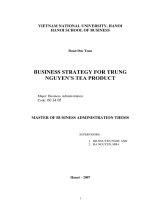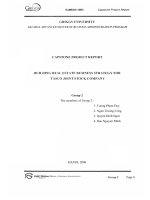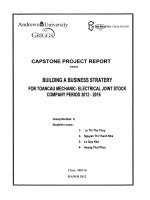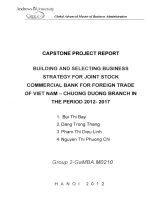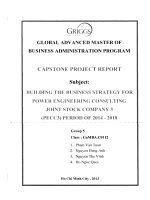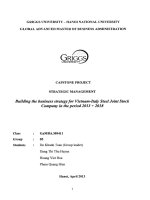Business strategy for trung nguyens tea product
Bạn đang xem bản rút gọn của tài liệu. Xem và tải ngay bản đầy đủ của tài liệu tại đây (901.02 KB, 105 trang )
VIETNAM NATIONAL UNIVERSITY, HANOI
HANOI SCHOOL OF BUSINESS
Doan Duc Toan
BUSINESS STRATEGY FOR
TRUNG NGUYEN’S TEA
PRODUCT
Major: Business Administration
Code: 60 34 05
MASTER OF BUSINESS ADMINISTRATION THESIS
SUPERVISORS:
1. DR.NGUYEN NGOC ANH
2. HA NGUYEN, MBA
Hanoi – 2007
1
Table of contents
Abstract……………………………………………………………………….i
Acknowledgements…………………………..……………………………….ii
List of figure………………………………….……………………… ………iii
List of table……………………………………..……………………………..iv
INTRODUCTION
1.
Necessity of the thesis ..........................................
2.
Purpose .................................................................
3.
Key research area ................................................
4.
Methodology .........................................................
5.
Constructions of the thesis ...................................
6.
Outline ..................................................................
Chapter 1: Literature review
1.1. Strategies .....................................................
1.2. Matching strategy to a company’s situatit
1.2.1.
1.2.2.
Industry Dev
Firm Capabi
1.3. Fuction strategies .....................................
Chapter 2: Case study of Trung Nguyen corporation on tea
industry
2.1
Case study method ......................
2.2.
Data presentation .......................
2.2.1
2.2.2.
2.2.3.
2.2.4
2.2.5.
2.2.6
Overall Mar
Consumption
Product and
Pricing Patte
Promotional
Entry and Ex
6
2.2.7
3.2.8.
Capital Investment Require
Trung Nguyen Company's C
2.3.
Data analysis ........................
2.3.1
2.3.2
2.3.3
2.3.4
Chapter 3: Recommendation and conclusion
3.1.
Successions and the action p
3.1.1.
3.1.2.
3.1.3.
3.1.4.
3.2.
Conclusion ...........................
REFERENCES
APPENDIX
7
LIST OF FIGURES
Figure 2.1 Tea Area
Figure 2.2 Area Under Cultivation
Figure 2.3 Province Growing Tea
Figure 2.4 Tea Out Put
Figure 2.5 Tea Export
LIST OF TABLES
Table 2.1 Growth Of Tea Area
Table 2.2 Growth Of Tea Area In Province
Table 2.3 Growth Of Tea Output Table 2.4
Growth Of Tea Export
Table 2.5 Consumptione
Table 2.6 Comparing Price Of End Product
Table 2.7 Comparing Price Of Meterial Table
2.8 Comparing Price Of Meterial Table 2.9
Comparing Price Of Meterial
5
INTRODUCTION
The first chapter will provide readers with an insight to the research area. It will
begin by briefly necessity of the thesis that will be followed by the purpose of the study and
research questions, key research area, methodology using for research and outline for
overall thesis.
1.
NECESSITY OF THE THESIS
In recently years, The Vietnam’s economy has been changed comprehensively. For
few years ago, state owned company is considered as backbone of national economy, but
now, we need to make an examination of it. Appearing in strongly way private enterprise,
specially, enterprises are descended from empty hands. By miraculous steps, those
enterprises have stepped up onto glorious dais, up to now, when search total process of
development of it, people only feel extremely miraculous and admire that can not talk by
word.
Trung Nguyen is one of those enterprises making miraculousness. To start by empty
hand, up to now, Trung Nguyen has become a very famous company. When looking back
in the history of Trung Nguyen, one can see that Trung Nguyen had difficult initial steps,
without property, traditional knowledge of business. With this difficult start, many other
companies would fell they began their businesses under a much better condition.
The history shows that successes only come with people who try one’s best by heart and
brain. By this element but is not other things, Trung Nguyen has made a success for itself.
8
I have been lucky having internship in Trung Nguyen for few months, both
acquiring sprit and learning experience. With assignment that complete graduated thesis, I
have chosen field tea, area that Trung Nguyen is newcomer.
Business strategy is compared as a map that looking it, people can know which path
is both reliable and shortest to succeed. Base on that, I have chosen subject: Built business
strategy for tea of Trung Nguyen. With general approach, do not go deep into the details of
each aspect of business action of Trung Nguyen, expected outcome will supply more
information for Trung Nguyen about tea industry in what stage of development process
with characteristics and strategies to succeed in that environment.
2.
PURPOSE
The purpose of this thesis is to study external and internal environment of Trung
Nguyen Company to define the optimal strategy for its tea products.
Research Question:
How to match strategy to a company's situation?
3.
KEY RESEARCH AREA
The scope of this thesis is limited to:
-
The tea industry in Vietnam and Trung Nguyen Corporation together with its
business strategies.
-
4.
Strategic choice that such a firm could apply in its own environment
METHODOLOGY
9
Methodology usually refers to the general approaches to research while method
refers to techniques for gathering evidence. Therefore, methodology is a theory and
analysis of how a research does or should proceed. Specific method for the case study will
be described and elaborated upon later in the chapter three of the thesis.
4.1.
Research Purpose
A research can classify into three basic purposes exploratory, descriptive and
explanatory. This study comes with descriptive and explanatory purpose more than
exploratory purposes only.
4.2.
Research Approach
The research approach of this study is qualitative. Qualitative research approaches
have traditional been favored when the main research objective is to improve the
understanding of a phenomenon is, especially when this phenomenon is complex and
deeply embedded in its context. Its many methodologies and techniques have helped
researcher get a better grasp of a variety of management situations.
4.3
Research Method
Research method were used in this thesis is case study. According to theory, a case
study approach should be used when how or why questions are being posed about a
contemporary set of events over which the researcher has little of any control. This study is
based on research question of how character and focuses on contemporary sets of events.
4.4
Data Collection Method
There are documentary sources, archival records, participant observation, and direct
observation. Each of these data sources has their strengths and weaknesses. Since no
10
single source of data have a complete advantage over all the others and given that the data
sources are highly complementary, and the recommendation by the researchers that a good
case study may want to use as many sources as possible. In this study data will be collected
from source: document, archival records, and direct observation.
4.5.
Data Analysis
There are two forms of analysis for the data collected in a case study: within case
analysis and cross case analysis. In my study, the within case analysis will be selected.
From examines raw data using many interpretations in order to find linkages
between the research object and the outcomes with reference to the original research
questions.
Data reduction: The process of collecting, focusing, simplifying, abstracting, and
transforming the data. The purpose is to organize the data so that final conclusions can be
drawn and verified.
Data display: Taking the resumed data and displaying it in an organized, as table, diagram,
to conclusion can be more easily drawn.
5.
CONTRIBUTIONS OF THE THESIS
Provision of an approach in building business strategy, which helps Trung Nguyen
Corporation in guiding its business activities.
Findings of the characteristics of environment of the tea industry in Vietnam, and the
position of Trung Nguyen in this industry.
Strategic analyses and recommendations in marketing, product operation, human
resource and finance to improve business activities.
11
6.
OUTLINE
The thesis is divided into four chapters:
The chapter one will provide readers with an insight to the research area. It will begin by
briefly necessity of the thesis that will be followed by the purpose of the study and research
questions, key research area, methodology using for research and outline for overall thesis.
The chapter two is a summary of relevant theories connected to the research questions.
Chapter three contains a case analysis to Trung Nguyen, including case study method,
analysis and findings of matching strategy to the firm’s company's situation.
Chapter four recommendations and conclusions will be presented.
12
CHAPTER 1:
LITTERATURE REVIEW
The chapter summaries theories connected to research questions. The literature
has been collected to address the research questions..
1.1.
STRATEGIES
A strategy is a long term plan of action designed to achieve a particular goal. Strategy
applies to many disparate fields, such as: Military strategy, Marketing strategies,
Strategic management, Football strategy, Game theoretical strategy, economic strategy,
Neuro-linguistic programming strategy.
1
A strategy in game theory is a sequence of activities and reactions, that fully determine
an agent’s behavior in a game or a business situation. The mathematically precise
description of behavior is connected to computer programming and algorithms.
2
In general, the plan or policy for arbitrating between multiple, concurrent requests for
the use of a device. Specifically in disk device drivers, the policy for scheduling
multiple, concurrent disk block-read and block-write requests.
3
A strategy is a long term plan for success, to achieve an advantage. In force terms .this
is the key milestones and targets for the coming year. These are based upon the
Governments PPAF requirement.
4
Describes the differentiating activities an organization pursues to gain competitive
advantage. Situated at the center of the Balanced Scorecard system, all performance
measures should align with the organization's strategy. Strategy
1Taken from website: en.wikipedia.org/wiki/Strategy
2Taken from website: en.wikipedia.org/wiki/Strategy_(game theory)
3Taken from website: biology.ncsa.uiuc.edu/library/SGI_bookshelves/SGI_Developer/books.html
4Taken from website: www.devon-cornwall.police.uk/v3/help/glossary.htm
13
Remains one of the most widely discussed and debated topics in the world of modern
organizations.
5
While matching in a dictionary several methods for comparing words can be used.
These methods are named strategies and include exact match, regular expression
match, and sounder match. The available strategies depends on the server, but a special
name can be used to denote a server-default strategy.
6
A plan for the conduct of a major phase, or campaign, within a grand strategy for the
overall conflict. A strategy is the basic idea of how the struggle of a specific campaign
shall develop, and how its separate components shall be fitted together to contribute
most advantageously to achieve its objectives. Strategy operates within the scope of the
grand strategy. Tactics and specific methods of action are used in smaller scale
operations to implement the strategy for a specific campaign.
7
1.2 MATCHING STRATEGY TO A COMPANY’S SITUATION
According to Thompson & Strickland III (1997), the task of matching strategy to a
company's situation is complicated because of the large external and internal factors
managers have to weigh. However, while the number and variety of considerations is
necessarily lengthy, the most important drivers shaping a company's strategic options
fall into two broad categories:
The nature of industry and competitive conditions.
The firm's own competitive capabilities, market position, and best opportunities.
5 Taken from website: www.balancedscorecard.biz/Glossary.html
6 Taken from website: www.myrkr.in-berlin.de/dictionary/using.html
7 Taken from website: www.canvasopedia.org/content/canvasopedia/dictionary.htm
14
The dominant strategy-shaping industry and competitive conditions revolve around:
1) What stage in his life-cycle the industry is in (emerging, rapid growth, mature,
declining).
2) The industry's structure (fragmented versus concentrated).
3) The nature and relative strength of the five competitive forces.
4) The scope of competitive rivalry (particularly whether the company's market is
globally competitive).
The pivotal company-specific considerations hinge on:
1) Whether the company is an industry leader, an up-and-coming challenger, a content
runner-up, or an also-ran struggling to survive.
2) The company's particular set of strengths, weaknesses, opportunities, and threats.
But even these few categories occur in too many combinations to cover here. However, we
can demonstrate what the task of matching strategy to the situation involves by considering
five classic types of industry environments:
1) Competing in emerging and rapidly growing industries.
2) Competing in maturing industries.
3) Competing in stagnant or declining industries.
4) Competing in fragmented industries.
And three classic types of company situations:
1) Firms in industry leadership positions.
2) Firms in runner-up positions.
15
3) Firms that is competitively weak or crisis-ridden.
According to Miller & Dess (1998), Industry life cycle, a conceptual model that suggests
that a market evolves through the stages of introduction, growth, maturity, and decline.
The industry life cycle provide a useful framework for studying business-level strategy
formulation because it provides" shorthand" for the numerous differences in strategic
situations and the behavior appropriate to each.
Product life cycles and technological life cycles are well-known, important concepts that
we have attempt to build into our consideration of an overall industry life cycle.
However, there are two caveats to bear in mind when considering the industry life cycle.
First, the industry life cycle is not intended to be use as a short-run forecasting device.
Strategists find it more useful to consider the industry life cycle as a conceptual framework
for understanding what changes might occur over time rather than when they are likely to
occur. Second, industry life cycles are reversible and repeatable
1.2.1.
Industry Development Stages
The following text will concentrate on characteristics and relevant strategies of four
different stages for industry. Four stages are: emerging, maturing, declining fragmented.
a- Competing in Emerging Industries
An emerging industry is one in the early, formative state. Most company in an emerging
industry are in a start-up mode, adding people, acquiring or constructing facilities, gearing
up production, trying to broaden distribution and gain buyer acceptance (Thompson &
Strickland III, 1997).
Characteristics
16
The market is new and unproven; there are many uncertainties about how it will function,
how fast it will grow, and how big it will get.
Much of the technological know-how tends to be proprietary and closely guarded, having
been developed in-house by pioneering firms; some firms may file patents in an effort to
secure competitive advantage.
Often, there is no consensus regarding which of several competing production technologies
will win out or which product attributes will gain the most buyer favor. Until market forces
sort these things out, wide differences in product quality and performance are typical and
rivalry centers around each firm's efforts to get the market to ratify its own strategic
approach to technology, product design, marketing, and distribution.
Entry barriers tend to be relatively low, even for entrepreneurial start-up companies; wellfinanced, opportunity-seeking outsiders are likely to enter if the industry has promise for
explosive growth.
Firms have little hard information about competitors, how fast products are gaining buyer
acceptance, and users' experiences with the product; there are no trade associations
gathering and distributing information.
Since all buyers are first-time users, the marketing task is to induce initial purchase and to
overcome customer concerns about product features, performance reliability, and
conflicting claims of rival firms.
Many potential buyers expect first-generation products to be rapidly improved, so they
delay purchase until technology and product design mature.firms have trouble securing
ample supplies of raw materials and components (until suppliers gear up to meet the
industry's needs).
17
Many companies, finding themselves short of funds to support needed R&D and get
through several lean years until the product catches on, end up merging with competitors
or being acquired by outsiders looking to invest in a growth market.
Strategies
- Try to win the early race for industry leadership with risk-taking entrepreneurship and a
bold, creative strategy. Broad or focused differentiation strategies keyed to product
superiority typically offer the best chance for early competitive advantage.
- Push to perfect the technology, to improve product quality, and to develop attractive
performance features.
- Try to capture any first-mover advantages associated with more models, better styling,
and early commitments to technologies and raw materials suppliers, experience curve
effects, and new distribution channels.
- Search out new customer groups, new geographical areas to enter, and new user
applications. Make it easier and cheaper for first-time buyers to try the industry's firstgeneration product.
- Gradually shift the advertising emphasis from building product awareness to increasing
frequency of use and creating brand loyalty.
- As technological uncertainty clears and a dominant technology emerges, adopt it quickly.
While there's merit in trying to pioneer the "dominant design" approach, such a strategy
carries high risk when there are many competing technologies, R&D is a costly, and
rapidly moving technological development quickly make early investments obsolete.
- Use price cuts to attract the next layer of price-sensitive buyers into the market.
18
- Expect well-financed outsiders to move in with aggressive strategies as industry sales
start to take off and the perceived risk of investing in the industry lessens. Try to prepare
for the entry of powerful competitors by forecasting (a) who the probable entrants will be
(based on present and future entry barriers) and (b) the types of strategies they are likely to
employ.
b- Competing in Maturing Industries
The rapid-growth environment of a young industry cannot go on forever. However, the
transition to a slower-growth, maturing industry environment does not begin on an easily
predicted schedule, and the transition can be forestalled by a steady stream of technological
advances, product innovations, or other driving forces that keep rejuvenating market
demand. Nonetheless, when growth rates do slacken, the transition to market maturity
usually produces fundamental changes in the industry's competitive environment.
Characteristics
Slowing growth in buyer demand generates more head-to-head competition for market
share. Firms that want to continue on a rapid-growth track start looking for ways to take
customers away from competitors. Outbreaks of price-cutting, increased advertising, and
other aggressive tactics are common.
Buyers become more sophisticated, often driving a harder bargain on repeat purchases.
Since buyers have experience with the product and are familiar with competing brands,
they are better able to evaluate different brands and can use their knowledge to negotiate a
better deal with sellers.
19
Competition often produces a greater emphasis on cost and service. As sellers all begin to
offer the product attributes buyers prefer, buyer choices increasingly depend on which
seller offers the best combination of price and service.
Firms have a "topping out" problem in adding production capacity. Slower rates of industry
growth mean slowdowns in capacity expansion. Each firm has to monitor rivals' expansion
plans and time its own capacity additions to minimize oversupply conditions in the
industry. With slower industry growth, the mistake of adding too much capacity too soon
can adversely affect company profits well into the future.
Product innovation and new end-use applications are harder to come by. Producers find it
increasingly difficult to create new product features, find further uses for the product, and
sustain buyer excitement.
International competition increases. Growth-minded domestic firms start to seek out sales
opportunities in foreign markets. Some companies, looking for ways to cut costs, relocate
plants to countries with lower wage rates. Greater product standardization and diffusion of
technological know-how reduce entry barriers and make it possible for enterprising foreign
companies to become serious market contenders in more countries. Industry leadership
passes to companies that succeed in building strong competitive positions in most of the
world's major geographic markets and in winning the biggest global market shares.
Industry profitability falls temporarily or permanently. Slower growth, increased
competition, more sophisticated buyers, and occasional periods of overcapacity put
pressure on industry profit margins. Weaker, less-efficient firms are usually the hardest hit.
Stiffening competition induces a number of mergers and acquisitions among former
competitors, drives the weakest firms out of the industry, and, in general, produces
20
industry consolidation. Inefficient firms and firms with weak competitive strategies can
survive in a fast-growing industry with booming sales. But the intensifying competition
that accompanies industry maturity exposes competitive weakness and throws second- and
third-tier competitors into a survival-of-the-fittest contest.
Strategies
- Pruning the Product Line: A wide selection of models, features, and product options has
competitive value during the growth stage when buyers' needs are still evolving. But such
variety can become too costly as price competition stiffens and profit margins are
squeezed. Maintaining too many product versions prevents firms from achieving the
economies of long production runs. In addition, the prices of slow-selling versions may not
cover their true costs. Pruning marginal products from the line lowers costs and permits
more concentration on items whose margins are highest and/or where the firm has a
competitive advantage.
- More Emphasis on Process Innovations: Efforts to "reinvent" the manufacturing process
can have a fourfold payoff: lower costs, better production quality, greater capability to turn
out multiple product versions, and shorter design-to-market cycles. Process innovation can
involve mechanizing high-cost activities, revamping production lines to improve labor
efficiency, creating self-directed work teams, reengineering the manufacturing portion of
the value chain, and increasing use of advanced technology (robotics, computerized
controls, and automatic guided vehicles). Japanese firms have become remarkably adept at
using manufacturing process innovation to become lower cost producers of higher-quality
products.
21
- A Stronger Focus on Cost Reduction: Stiffening price competition gives firms extra
incentive to reduce unit costs. Such efforts can cover a broad front: companies can push
suppliers for better prices, switch to lower-priced components, develop more economical
product designs, cut low-value activities out of the value chain, streamline distribution
channels, and reengineer internal processes.
- Increasing Sales to Present Customers: In a mature market, growing by taking customers
away from rivals may not be as appealing as expanding sales to existing customers.
Strategies to increase purchases by existing customers can involve providing
complementary items and ancillary services, and finding more ways for customers to use
the product. Convenience food stores, for example, have boosted average sales per
customer by adding video rentals, automatic bank tellers, and deli counters.
- Purchasing Rival Firms at Bargain Prices: Sometimes the facilities and assets of
distressed rivals can be acquired cheaply. Bargain-priced acquisitions can help create a
low-cost position if they also present opportunities for greater operating efficiency. In
addition, an acquired firm's customer base can provide expanded market coverage. The
most desirable acquisitions are those that will significantly enhance the acquiring firm's
competitive strength.
- Expanding Internationally: As its domestic market matures, a firm may seek to enter
foreign markets where attractive growth potential still exists and competitive pressures are
not so strong. Several manufacturers in highly industrialized nations found international
expansion attractive because equipment no longer suitable for domestic operations could
be used in plants in less-developed foreign markets (a condition that lowered entry costs).
Such possibilities arise when (1) foreign buyers have less sophisticated needs and have
22
simpler, old-fashioned, end-use applications, and (2) foreign competitors are smaller, less
formidable, and do not employ the latest production technology. Strategies to expand
internationally also make sense when a domestic firm's skills, reputation, and product are
readily transferable to foreign markets. Even though the U.S. market for soft drinks is
mature, Coca-Cola has remained a growth company by upping its efforts to penetrate
foreign markets where soft-drink sales are expanding rapidly.
c- Competing in Stagnant or Declining Industries
Many firms operate in industries where demand is growing more slowly than the economy
wide average or is even declining. Although harvesting the business to obtain the greatest
cash flow, selling out, or closing down are obvious end-game strategies for uncommitted
competitors with dim long-term prospects, strong competitors may be able to achieve good
performance in a stagnant market environment. Stagnant demand by itself is not enough to
make an industry unattractive. Selling out may or may not be practical, and closing
operations is always a last resort.
Characteristics
Businesses competing in slow-growth/declining industries have to accept the difficult
realities of an environment of continuing stagnation, and they must resign themselves to
performance targets consistent with available market opportunities. Cash flow and returnon-investment criteria are more appropriate than growth-oriented performance measures,
but sales and market share growth are by no means ruled out. Strong competitors may be
able to take sales from weaker rivals, and the acquisition or exit of weaker firms creates
opportunities for the remaining companies to capture greater market share.
Strategies
23
- Pursue a focused strategy by identifying, creating, and exploiting the growth segments
within the industry. Stagnant or declining markets, like other markets, are composed of
numerous segments or niches. Frequently, one or more of these segments is growing
rapidly, despite stagnation in the industry as a whole. An astute competitor who is first to
concentrate on the attractive growth segments can escape stagnating sales and profits and
possibly achieve competitive advantage in the target segments.
- Stress differentiation based on quality improvement and product innovation. Either
enhanced quality or innovation can rejuvenate demand by creating important new growth
segments or inducing buyers to trade up. Successful product innovation opens up an
avenue for competing besides meeting or beating rivals' prices. Differentiation based on
successful innovation has the additional advantage of being difficult and expensive for
rival firms to imitate.
Work diligently and persistently to drive costs down. When increases in sales cannot be
counted on to generate increases in earnings, companies can improve profit margins and
return on investment by continuous productivity improvement and cost reduction year after
year. Potential cost-saving actions include (a) outsourcing functions and activities that can
be performed more cheaply by outsiders, (b) completely redesigning internal business
processes, (c) consolidating underutilized production facilities, (d) adding more
distribution channels to ensure the unit volume needed for low-cost production, (e) closing
low-volume, high-cost distribution outlets, and (f) cutting marginally beneficial activities
out of the value chain.
d- Competing in Fragmented Industries
24
A number of industries are populated by hundreds, even thousands, of small and mediumsized companies, many privately held and none with a substantial share of total industry
sales. The standout competitive feature of a fragmented industry is the absence of market
leaders with king-sized market shares or widespread buyer recognition. Examples of
fragmented industries include book publishing, landscaping and plant nurseries, kitchen
cabinets, oil tanker shipping, auto repair, restaurants and fast-food, public accounting,
women's dresses, metal foundries, meat packing, paperboard boxes, log homes, hotels and
motels, and furniture.
Characteristics
Low entry barriers allow small firms to enter quickly and cheaply. An absence of largescale production economies permits small companies to compete on an equal cost footing
with larger firms. Buyers require relatively small quantities of customized products (as in
business forms, interior design, and advertising); because demand for any particular
product version is small, sales volumes are not adequate to support producing, distributing,
or marketing on a scale that yields advantages to a large firm.
The market for the industry's product/service is local (dry cleaning, residential
construction, medical services, automotive repair), giving competitive advantage to local
businesses familiar with local buyers and local market conditions.
Market demand is so large and so diverse that it takes very large numbers of firms to
accommodate buyer requirements (restaurants, energy, and apparel).
High transportation costs limit the radius a plant can economically service—as in concrete
blocks, mobile homes, milk, and gravel.
Local regulations make each geographic area somewhat unique.
25
The industry is so new that no firms have yet developed the skills and resources to
command a significant market share.
Strategies
- Constructing and operating "formula" facilities: This strategic approach is frequently
employed in restaurant and retailing businesses operating a multiple locations. It involves
constructing standardized outlets in favorable locations at minimum cost and then
polishing to a science how to operate all outlets in a super efficient manner. McDonald's,
Home Depot, and 7-Eleven have pursued this strategy to perfection, earning excellent
profits in their respective industries.
- Becoming a low-cost operator: When price competition is intense and profit margins are
under constant pressure, companies can stress no-frills operations featuring low overhead,
high-productivity/low-cost labor, lean capital budgets, and dedicated pursuit of total
operating efficiency. Successful low-cost producers in a fragmented industry can play the
price-cutting game and still earn profits above the industry average.
- Increasing customer value through integration: Backward or forward integration may
contain opportunities to lower costs or enhance the value provided to customers. Examples
include assembling components before shipment to customers, providing technical advice,
or opening regional distribution centers.
- Specializing by product type: When a fragmented industry's products include a range of
styles or services, a strategy to focus on one product/service category can be very effective.
Some firms in the furniture industry specialize in only one furniture type such as brass
beds, rattan and wicker, lawn and garden, or early American. In auto repair, companies
specialize in transmission repair, body work, or speedy oil changes.
26
